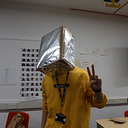22/04/21–10/06/21 (7 weeks)
📃Brief: Design a way to materialise the blockchain.
🤝Group Members: Alex Newson, Tatiana Bohsali, Sue Heeyeon An, Yiwei Han (David).
👁🗨External Partner: This Ain’t Rock’n’Roll — Charlie Waterhouse, Clive Russell
In the second week, we did three main things: micro-analysis of the application for cryptocurrencies; holding a workshop to discuss the fairness of PPoS and explore consensus mechanisms; and literature research.
Literature Research
Alaistair recommended a book on Blockchain to us and we decided to pick a few chapters to read: Tatiana read an interesting chapter on Proof of “Purr”; Sue read a chapter on some blockchain platforms becoming new intermediaries charging de-artist fees (an example of Blockchain being misused). I read the fascinating chapter about people using the blockchain’s immutability and public transparency to record their wedding vows and even perform weddings (Proof of Love on the blockchain, saying goodbye to traditional churches and state institutions). Alex read a chapter on “Plantoid”, a Blockchain-based lifeform that entices people to donate through flesh and incentives, and then uses Smart Contracts to self-propagate. This is a good example of the materialisation of Blockchain.
“Life is not eternal and death can separate us, but the Blockchain is forever.” — David Mondrus and Joyce Bayo on their blockchain wedding
“Participating” the Blockchain
Sue and I have spent a lot of time working on Blockchain in the digital currency field. There were three main operations we wanted to accomplish:
- Create an account and buy cryptocurrency;
- Transfer $0 to ourselves to create a transaction record;
- Attach our information to this transaction record and check in a blockchain explorer.
But was the whole process difficult and tedious despite the fact that we contacted people with knowledge to guide us. The main reasons for the difficulty of the experience are:
1. the field is not maturely developed and the need to operate requires cross-platform collaboration to achieve. (too many steps)
2. the language of the interface is mostly financial jargon and blockchain jargon. (too much cognitive load)
3. blockchain updates are inefficient and prioritise transactions for those paying a higher Gas Fee. (Disadvantages of blockchain and unfair mechanisms)
“Discussing” the Consensus Mechanism
During the group discussion, we found that PPoS is the fairest consensus mechanism available — Instead of based on people’s computer processing power or stake proportions, the PPoS selects a algo holders from committee via unique cryptographic randomization tool- VRF(Verifiable random function).
However, we still had doubts about its “randomness”. So Alex and Tatiana decided to use the Workshop to explore a fairer consensus mechanism. The participants finally came up with a very straightforward way (spinning the wheel) to replace the random mechanism of PPoS.
Presentation
We used the paper version to present what we did this week. We started by reintroducing the basic concepts of blockchain through a simple model. Then presented the takeaways from our literature research and a micro-analysis of the cryptocurrency market experience. John appreciated our presentation and suggested that we look for more examples like Plantoid and critically analyse them. He also asked us thought-provoking questions:
- If we can add information into Blockchain metabases, then we need to think about what’s next? who reads it? How? When? Why?
- How do we tokenize community approval as a social meterial?
Alaistair also suggested that we had left out the Brixton part, as this is a Brixton-related project after all.
Reflection
“If I had asked people what they wanted, they would have said faster horses.”
— Henry Ford
Perhaps the downside of this week’s presentation was that we didn’t prepare the questions properly for the feedback session and therefore didn’t make the most of it. The main reason was that our questions were too meaningless or too vague? We can’t simply ask people what they want, but think and explore what is available and offer some options or references. We need to have a starting point, open up the questions and make them specific or we will again face a wall of silence.
Also, always ask permission from someone before recording or filming them, otherwise the consequences of being caught are unthinkable.
📚References
Catlow, R., Garrett, M., Jones, N. and Skinner, S., 2017. Artists Re: thinking the Blockchain (Vol. 1, №3rd). Torque editions.
Hanington, B. and Martin, B., 2019. Universal methods of design expanded and revised: 125 Ways to research complex problems, develop innovative ideas, and design effective solutions. Rockport publishers.
Neale, S. (2021). GETTING MARRIED AND DIVORCED ON THE BLOCKCHAIN. [online] Libertarianism.org. Available at: https://www.libertarianism.org/building-tomorrow/getting-married-and-divorced-blockchain [Accessed 5 Jun. 2021].
Rawat, D., Chaudhary, V. and Doku, R. (2019). Blockchain: Emerging Applications and Use Cases.
